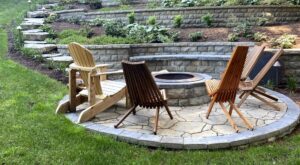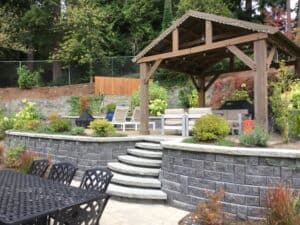
There are a variety of materials to choose from when deciding to build a retaining wall. We in Western Washington have an advantage, because some of the best natural stone available is quarried in our own backyard.
The advantages to our native stone are that the color, texture, and size vary and no two stones are the same. The beauty of the blues, grays, browns, and greens in the stone as it ages shows beautifully in any setting. The classic appeal of Carderock conveys strength and beauty unmatched by none.
There are two types of retaining walls that can be built with our native stones. We can build a dry stack wall where we do not use mortar to adhere the stones together. The stone used is usually flat so they stack better. Our customer’s favorite wall is built with veneer stone.
The process for building a veneer wall starts with excavation for a “footing” or base of the wall. The size of the footing depends on the height of the wall, but we always meet or exceed the local building codes. Our footings typically are reinforced concrete with rebar to tie the wall and footing together. Next we build an 8” cinder block wall on top of the footing. At the time of the block wall’s construction, we install 1-2” pvc pipe passing through the wall for the drainage system.
Our expertly trained stonemasons “work the stone” for the best face and corners of the stone. High strength mortar is used to adhere the stone to the block wall. The purpose of working the stone is to have a final product that has small joints between the stone for a seamless appearance. The top of the wall can be given a natural cap. A natural cap is a finished cap that matches the face of the wall, only with larger stones. By far our customer’s favorite type of cap is flagstone. For the best appearance a thick Pennsylvania blue flagstone is installed and overhangs the wall’s face by an inch.

The biggest enemy of retaining walls, no matter the material, is the natural elements. Water is the most destructive of them all. Hydrostatic pressure is the force exerted by water behind a wall that pushes on it. A properly constructed wall with correct “back filling” will last many generations. When the construction of the wall is near completion, a drainage system is installed behind it. This system has three main components, a perforated pipe, gravel backfill and landscaping fabric.
The pipe is used to collect and direct water away from the wall. The gravel offers free movement of water behind the wall, therefore reducing the hydrostatic pressure. The landscape fabric is used to isolate the gravel from the existing soil and ensure that the drain pipe runs clear and does not become choked with silt in the future. Also, any excess water that does not enter the pipe travels down and passes through the pvc weep holes and exits at ground level in the front of the wall.
Through training and experience, our stonemasonry crews bring a passion for the highest quality product to your project. Our crews produce some of the longest lasting and most beautiful walls in the area.
Contact us today to discuss stone walls!
